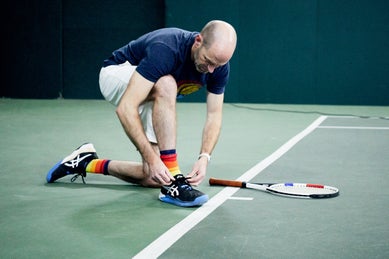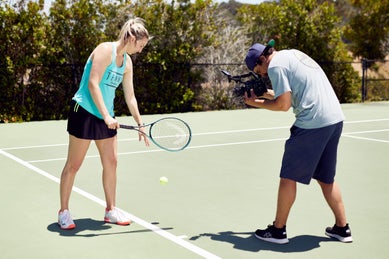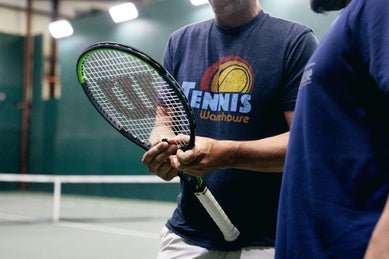TO playtester dictionary
Ever wondered what a playtester meant in a review when describing a racquet, shoe or string? Below is a list of frequently used words and definitions explained by the playtesters including an indiciation if they are positive (+), negative (-) or neutral (neutral) attributes.


Racquet Terms
Ball Pocketing- the ability of the ball to sink into the string bed (neutral)
Brassy- too stiff and harsh, uncomfortable, hollow (-)
Crisp- clean maybe stiffer feel, point and shoot (+)
Dampened- reduced vibrations, softer feel, comfort (+)
Dwell time- the amount of time a ball sits on the stringbed
Feel- connection to the ball (neutral)
Flexible- soft feeling, more control and comfort, feel the racquet bending (neutral)
Frame- refers to the physical racquet minus strings including the hoop, throat and grip
Harsh- uncomfortable, stiff, not forgiving, too firm (-)
Launch Angle- angle of the ball leaving the string bed (neutral)
Muted- blocks productive feedback, too dampened, reduced feel and vibrations (-)
Playability- overall response and feel the racquet offers, how the racquet suits the game (+)
Plow Through- stable, displacement on impact, heavier racquet, ability of the racquet to go
Plush- high degree of comfort, soft feeling, ball pocketing, dampened without feeling muted (+)
Point and Shoot- precise feeling, aiming the racquet at a target and the ball following
Responsive- does what it is supposed to do for the player through the ball, higher swingweight (+)
Scalpel- racquet feels surgical and precise, full of control and accuracy
Soft- forgiving, comfortable, good ball pocketing, flexible (neutral)
Solid- stable feeling, no twisting (+)
Stability- how secure the racquet feels after making contact with the ball
Stiff- firm feeling, creates more power, can cause discomfort (neutral)
String bed- the area of the racquet where the strings are intertwined
Wheelhouse- range of specs a playtester prefers


Shoe Terms
Arch support- the shoes ability to offer structure for the arch of the foot
Bootie / Monosock Construction- construction of the shoe with a uni-sock tongue for a more seamless fit
Break-in Period- the amount of time it takes for a shoe to feel comfortable and flex well
Chassis- located in the midsole, a piece offering stability
Comfort- a combination of cushioning and fit for an overall feel
Cushioning- the padding underfoot, around the tongue and heel that contributes to the overall comfort
Durability- the endurance of an outsole and toe bumper over the course of time
Fit- how the shoe feels on the foot width and length wise
Flexible- shoe's transition for toe to heel, uppers ability to mold around the foot (neutral)
Forefoot- the front part of the shoe where the toe box is located
Glove-like Fit- the shoe wraps around the foot tightly and supportively without any extra room (+)
Heel Counter- the back part of the shoe designed to keep the heel in place
Herringbone- type of tread pattern on the outsole
Insole- the piece on the bottom of the inisde of the shoe where the bottom of the foot makes direct contact, can be removeable
Last- part of the shoe that curves in slightly where the arch is, mimics shoe foot shape
Lateral- side of the shoe facing outward
Light Weight- typically a weight under 14 ounces for men and 12 ounces for women (neutral)
Low to the Ground- when the foot is in the shoe, it feels like it is sitting deep in the shoe close to the ground (+)
Medial- side of the shoe facing the middle of the body
Midfoot- the middle section of the shoe
Midsole- the layer in between the insole and outsole
Outsole- the exposed part of the sole that makes contact with the court
Responsive- the shoes ability to bounce back quickly, typically with firmer cushioning (+)
Riding High- when the foot is in the shoe, it feels like it is sitting high in the shoe up off the ground (-)
Shank- located in the midfoot, a piece of material (usually TPU) located in the midsole offering additional support/stability
Stability- how the shoe holds your foot from going over the last
Stiff- doesn't flex well, typically has a break in period (-)
Support- how the shoe holds your foot in place within the shoe
Toe Box- area within the shoe where the front of the foot sits
Toe Bumper- the protective piece on the outside of the shoe above the outsole and sits on the upper, helps prevent damage from toe dragging
Traction- the way the outshoe grips the court, can be more sticky or slick
Transition Heel to Toe- the way the shoe flexes and feels when landing at the heel and rolling onto the toes during a step (neutral)
Tread Pattern- the pattern on the outsole of the shoe
Upper- the material on the top of the shoe that surrounds the foot
Vamp- part of the upper specifically in the front where the laces are located
Ventilation- how breathable the shoe is specifically in the upper


String Terms
Actual Tension- tension of strung racquet at any given time, different from reference tension, which is the tension the strings are pulled to during installation
Bite- high string on ball friction. Higher bite = higher spin-potential (+)
Boardy- overly firm (-)
Brassy- too stiff, harsh, uncomfortable (-)
Crisp -firm, direct and clean feedback without discomfort, point and shoot(+)
Clean - smooth feel without being mushy or leaving player feeling disconnected (+)
Co-polyester (co-poly)- polyester monofilament with additives to enhance feel and performance
Coil-Memory- a string's resistance to straightening during installation (neutral) High coil memory (-)
Control- low ball speed (neutral) ease of placement (+)
Comfort- low impact vibration and shock, typically experienced with natural gut, multifilaments and lower tensions (+)
Composition- string material, e.g., synthetic polymers (polyester, nylon, kevlar, zyex). Natural material / serosa membrane = natural gut
Construction- string structure, e.g., monofilament, multifilament, solid core, multicore
Connected- heightened command over shot placement based on optimal ball feedback (+)
Cross Strings (Crosses)- horizontal strings in a racquet
Dampened- reduced vibrations, softer feel, comfort (+)
Dead- unresponsive and/or powerless feel, typically associated with tension loss, stiff polyesters, and/or overly high tensions (-)
Disconnected- when a player cannot sense where impact is made on the stringbed nor gauge the resulting shot's speed, trajectory and placement (-)
Dwell Time- length of time a ball is on the string bed (neutral)
Durabilty- how easily a string breaks (neutral)
Elasticity- the degree to which a string stretches and returns to its original position. High elasticity = more power & comfort. Low elasticity = more control & less comfort. (neutral)
Feedback- feel, typically in the form of impact vibration which affects the degree to which the player feels connected to the ball and/or the resulting shot (neutral)
Feel- see feedback
Firm- stiffer feel, typically associated with less power and lower comfort but more control (neutral)
Fraying- when a string's layers and/or filaments peel, become dislodged or exposed (-)
Friction- resistance to movement (neutral) low friction increases snapback and durability (+)
Gauge- thickness/diameter of a string
Gut-like- when a synthetic string has similar comfort, responsiveness and/or plushness to natural gut (+)
Grippy (or Grip)- see bite
Harsh- uncomfortable, stiff, not forgiving, too firm (-)
Lively- higher power (neutral)
Main Strings (Mains)- vertical strings in a racquet
Monofilament- string construction with single extrusion of material without wraps
Multicore- string construction witth two or more large central cores, enclosed by one or more wraps
Multifilament- string construction with core comprised of 100s or 1000s of thin filaments
Mushy- too soft, typically associated with disconnected feel and erratic trajectory response (-)
Muted- blocks productive feedback, too dampened, reduced feel and vibrations (-)
Natural Gut- string composition, highly elastic fibers made from cow intestines
Notching- divots in a string that occur during installation and/or repeated ball impact. Typically results in strings getting stuck out of place, leads to sub-optimal performance and premature breakage (neutral)
Nylon- polyamide polymer typically used to make synthetic gut and multifilament strings
Playability Duration- the length of time a stringbed retains optimal playing characteristics (neutral)
Plush- high degree of comfort, soft feeling, ball pocketing, dampened without feeling muted (+)
Pocketing- the feeling at impact like a pocket is forming around the ball (neutral), often credited with increasing control and spin-potential (+)
Poly- polyester-based monofilament (neutral)
Polyamide- technical term for nylon
Polyester- polyester polymer typically consisting of polyethylene terephthalate (PET, PETE). Used primarily for monofilaments, occasionally for multifilaments
Polymer- molecular structure of synthetic strings, e.g., nylon, polyester.
Polyurethane- surface treatment that reduces inter-string friction & increases durability. Also, internal bonding resin used to fuse filaments
Powerful- high ball speed (neutral)
Predictable- string response where the ball's exit trajectory, depth and placement are easy to gauge (+)
Pre-stretching (during-installation)- pulling a string at a fixed percentage over the reference tension to reduce tension loss (+)
Pre-stretching (pre-installation)- manual stretching of string for easier handing during installation. Typically done with natural gut to avoid kinking & premature breakage (+)
Reference Tension- machine tension used for installation, different from actual tension
Resin- material used to bond internal filaments of a string (neutral)
Responsive- optimal performance at a given stroke speed. Opposite of dead (+)
Rough- textured surface, typically designed to increase string on ball friction for enhanced spin-potential (neutral)
Settle-in- initial tension loss of a stringbed, typically resulting in a softer, more powerful feel (+)
Shaped- string construction, non-round, typically with sharper edges to enhance bite and spin-potential. (neutral)
Snap Back- low string on string friction, marked by the ability of main strings to deflect then return to original alignment during impact. Enhances spin-potential (+)
Solid Core- single or multi core string with one or more wraps. Typically called synthetic gut (neutral)
Spin-friendly- a string or the properties of a string that help with spin generation (+)
Stiff- firm feel, sometimes associated with discomfort (-)
Stiffness- the force necessary to move a string a given distance. Determines the power, comfort and feel of a stringbed (neutral)
String Movement- displacement of strings from their original position (neutral), requires manual realignment (-), snaps back to original position (+)
Sweetspot- the location on stringbed where there is the least vibration at ball impact, associated with high comfort and power
Synthetic Gut- string construction typically referring to solid core nylon strings (neutral)
Tensile Strength- the force required to break a string on a straight pull (neutral)
Tension Loss- the amount a stringbed has lost tension (neutral) often resulting in compromises to feel and control (-)
Tension Maintenance- percentage of original tension retained (neutral)
Traditional Poly- monofilament made of 100% polyester with no additives (neutral)
Trajectory Response- the arch of a struck ball. Can be higher or lower based on string material and actual tension (neutral)
Trampoline Effect- when a softer and more resilient stringbed launches the ball with extra energy and, typically, a higher trajectory (neutral)
Wrap- thin coverings that surround a string's core to enhance feel and/or durability. Most commonly found on single/multi core and multifilament strings